Adaptive reduction of human myometrium contractile activity in response to prolonged uterine stretch during term and twin pregnancy. Role of TREK-1 channel
- PMID: 29577872
- PMCID: PMC5960639
- DOI: 10.1016/j.bcp.2018.03.021
Adaptive reduction of human myometrium contractile activity in response to prolonged uterine stretch during term and twin pregnancy. Role of TREK-1 channel
Abstract
Quiescence of myometrium contractile activity allows uterine expansion to accommodate the growing fetus and prevents preterm labor particularly during excessive uterine stretch in multiple pregnancy. However, the mechanisms regulating uterine response to stretch are unclear. We tested the hypothesis that prolonged uterine stretch is associated with decreased myometrium contractile activity via activation of TWIK-related K+ channel (TREK-1). Pregnant women at different gestational age (preterm and term) and uterine stretch (singleton and twin pregnancy) were studied, and uterine strips were isolated for measurement of contractile activity and TREK-1 channel expression/activity. Both oxytocin- and KCl-induced contraction were reduced in term vs preterm pregnancy and in twin vs singleton pregnancy. Oxytocin contraction was reduced in uterine segments exposed to 8 g stretch compared to control tissues under 2 g basal tension. TREK-1 mRNA expression and protein levels were augmented in Singleton-Term vs Singleton-Preterm, and in uterine strips exposed to 8 g stretch. The TREK-1 activator arachidonic acid reduced oxytocin contraction in preterm and term, singleton and twin pregnant uterus. The TREK-1 blocker l-methionine enhanced oxytocin contraction in Singleton-Term and twin pregnant uterus, and reversed the decreases in contraction in uterine strips exposed to prolonged stretch. Carboprost-induced uterine contraction was also reduced by arachidonic acid and enhanced by l-methionine. Thus, myometrium contraction decreases with gestational age and uterine expansion in twin pregnancy. The results suggest that prolonged stretch enhances the expression/activity of TREK-1 channel, leading to decreased myometrium contractile activity and maintained healthy term pregnancy particularly in multiple pregnancy.
Keywords: Contraction; Potassium channel; Pregnancy; Stretch; Uterus.
Copyright © 2018 Elsevier Inc. All rights reserved.
Conflict of interest statement
None
Figures
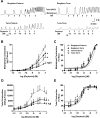

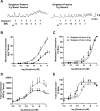
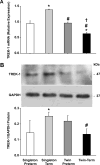
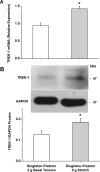
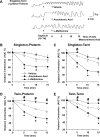

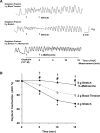
Similar articles
-
Expression of stretch-activated two-pore potassium channels in human myometrium in pregnancy and labor.PLoS One. 2010 Aug 25;5(8):e12372. doi: 10.1371/journal.pone.0012372. PLoS One. 2010. PMID: 20811500 Free PMC article.
-
A comparison of the contractile properties of myometrium from singleton and twin pregnancies.PLoS One. 2013 May 6;8(5):e63800. doi: 10.1371/journal.pone.0063800. Print 2013. PLoS One. 2013. PMID: 23671701 Free PMC article.
-
The combination tocolytic effect of magnesium sulfate and an oxytocin receptor antagonist in myometrium from singleton and twin pregnancies.Am J Obstet Gynecol. 2016 Dec;215(6):789.e1-789.e9. doi: 10.1016/j.ajog.2016.08.015. Epub 2016 Aug 20. Am J Obstet Gynecol. 2016. PMID: 27555315
-
A role of stretch-activated potassium currents in the regulation of uterine smooth muscle contraction.Acta Pharmacol Sin. 2011 Jun;32(6):758-64. doi: 10.1038/aps.2011.62. Acta Pharmacol Sin. 2011. PMID: 21642947 Free PMC article. Review.
-
A short review of twin pregnancy and how oxytocin receptor expression may differ in multiple pregnancy.Eur J Obstet Gynecol Reprod Biol. 2009 May;144 Suppl 1:S40-4. doi: 10.1016/j.ejogrb.2009.02.011. Epub 2009 Mar 19. Eur J Obstet Gynecol Reprod Biol. 2009. PMID: 19303192 Review.
Cited by
-
High glucose induced HIF-1α/TREK1 expression and myometrium relaxation during pregnancy.Front Endocrinol (Lausanne). 2023 Feb 27;14:1115619. doi: 10.3389/fendo.2023.1115619. eCollection 2023. Front Endocrinol (Lausanne). 2023. Retraction in: Front Endocrinol (Lausanne). 2025 Mar 14;16:1589452. doi: 10.3389/fendo.2025.1589452. PMID: 36909311 Free PMC article. Retracted.
-
KCNK2-mediated regulation of MMP-2/9 by PlGF influences uterine artery function in pregnancy-induced hypertension.BMC Pregnancy Childbirth. 2025 Jun 2;25(1):646. doi: 10.1186/s12884-025-07743-5. BMC Pregnancy Childbirth. 2025. PMID: 40457264 Free PMC article.
-
Role of potassium channels in female reproductive system.Obstet Gynecol Sci. 2020 Sep;63(5):565-576. doi: 10.5468/ogs.20064. Epub 2020 Aug 25. Obstet Gynecol Sci. 2020. PMID: 32838485 Free PMC article.
-
Multiple pregnancies, the myometrium and the role of mechanical factors in the timing of labour.Curr Res Physiol. 2023 Aug 24;6:100105. doi: 10.1016/j.crphys.2023.100105. eCollection 2023. Curr Res Physiol. 2023. PMID: 38107788 Free PMC article.
-
Novel identification and modulation of the mechanosensitive Piezo1 channel in human myometrium.J Physiol. 2023 May;601(9):1675-1690. doi: 10.1113/JP283299. Epub 2022 Aug 8. J Physiol. 2023. PMID: 35941750 Free PMC article.
References
-
- Arrowsmith S, Kendrick A, Hanley JA, Noble K, Wray S. Myometrial physiology–time to translate? Exp Physiol. 2014;99:495–502. - PubMed
-
- de Ziegler D, Bulletti C, Fanchin R, Epiney M, Brioschi PA. Contractility of the nonpregnant uterus: the follicular phase. Annals of the New York Academy of Sciences. 2001;943:172–84. - PubMed
-
- Kunz G, Beil D, Deiniger H, Einspanier A, Mall G, Leyendecker G. The uterine peristaltic pump. Normal and impeded sperm transport within the female genital tract. Adv Exp Med Biol. 1997;424:267–77. - PubMed
-
- Parkington HC, Coleman HA. Ionic mechanisms underlying action potentials in myometrium. Clin Exp Pharmacol Physiol. 1988;15:657–65. - PubMed
-
- Fortunato SJ, Menon R. Distinct molecular events suggest different pathways for preterm labor and premature rupture of membranes. Am J Obstet Gynecol. 2001;184:1399–405. discussion 405-6. - PubMed
Publication types
MeSH terms
Substances
Grants and funding
LinkOut - more resources
Full Text Sources
Other Literature Sources
Medical

